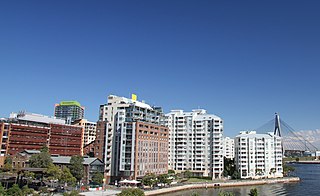
Pyrmont is an inner-city suburb of Sydney, in the state of New South Wales, Australia 2 kilometres south-west of the Sydney central business district in the local government area of the City of Sydney. It is also part of the Darling Harbour region.

Ultimo is an inner-city suburb of Sydney, New South Wales, Australia. It is adjacent to the Sydney central business district in the local government area of the City of Sydney west of the Darling Harbour area, and is bordered by Pyrmont to the north, the Sydney CBD and Chinatown/Haymarket to the east, Broadway and Chippendale to the south, and Glebe and Wentworth Park to the west.

Colonel Walter Liberty Vernon was an English architect who migrated to Australia and pursued his career as an architect in Sydney, New South Wales. In his role as the New South Wales Government Architect he is noted for designing multiple government buildings, many of which are extant with listings on national and state heritage registers.

Hastings is a heritage-listed former residence and now multiple residences at 2 Hayes Street, Neutral Bay, North Sydney Council, New South Wales, Australia. The 1913 house was reputedly designed by Edward Jeaffreson Jackson and built from 1830 to 1913. It is also known as Thrupp's Cottage; Craignathan; The Hastings; Milton. The property is privately owned. It was added to the New South Wales State Heritage Register on 2 April 1999.

Pyrmont Post Office is a heritage-listed former post office and now bank branch office located at 148 Harris Street, in the inner city Sydney suburb of Pyrmont in the City of Sydney local government area of New South Wales, Australia. It was designed by the Government Architect’s Office under Walter Liberty Vernon. The property is owned by Australia Post, an agency of the Commonwealth Government of Australia. It was added to the Australian Commonwealth Heritage List on 22 June 2004 and to the New South Wales State Heritage Register on 22 December 2000.

The Katoomba Post Office is a heritage-listed former post office and now retail building at 59-61 Katoomba Street, Katoomba, City of Blue Mountains, New South Wales, Australia. It was designed by NSW Government Architect's office. It is also known as Katoomba Post Office (former). It was added to the New South Wales State Heritage Register on 22 December 2000.

The Ultimo Substation is a heritage-listed electrical substation located at 41 Mountain Street in the inner city Sydney suburb of Ultimo in the City of Sydney local government area of New South Wales, Australia. It was built in 1906. It is also known as #5 Mountain Street. The property is owned by Ausgrid, an agency of the Government of New South Wales. It was added to the New South Wales State Heritage Register on 2 April 1999.

The Ultimo Sewage Pumping Station is a heritage-listed sewerage pumping station located at William Henry Street in the inner city Sydney suburb of Ultimo in the City of Sydney local government area of New South Wales, Australia. As a result of the construction of an elevated roadway along William Henry Street, the pumping station now fronts Pyrmont Street, with vehicles being required to enter via Quarry Street, then turning right into Pyrmont Street.

The Brooklyn Hotel is a heritage-listed bar, restaurant and former hotel located at 229 George Street, in the suburb of The Rocks, in the city of Sydney, New South Wales, Australia. It was designed by Walter Liberty Vernon and built in 1912. The property is owned by Property NSW, an agency of the Government of New South Wales. It was added to the New South Wales State Heritage Register on 10 May 2002.
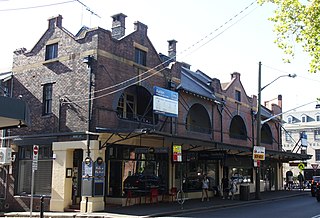
21–29 Kent Street is a heritage-listed row of shops with second-storey residences at 21, 23, 25, 27 and 29 Kent Street, in the inner city Sydney suburb of Millers Point in the City of Sydney local government area of New South Wales, Australia. It is also known as Edwardian Shop and Residences. It was added to the New South Wales State Heritage Register on 2 April 1999.
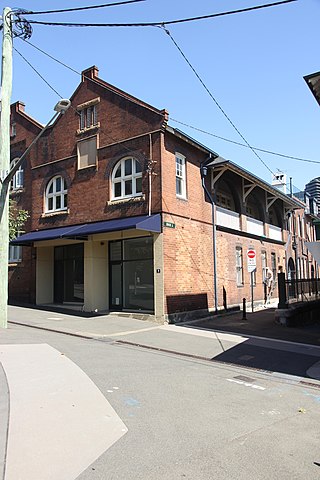
9 Argyle Place is a heritage-listed residence and commercial building at 9 Argyle Place, Millers Point, City of Sydney, New South Wales, Australia. It was built in 1910. It was added to the New South Wales State Heritage Register on 6 June 2003.
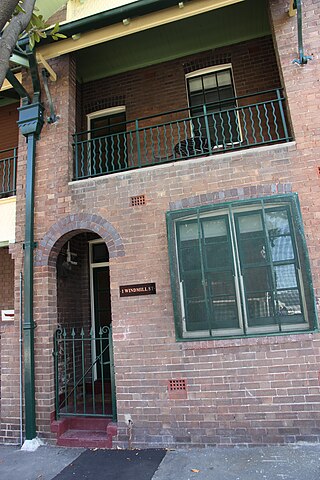
1–63 Windmill Street, Millers Point is a heritage-listed residence located at 1–63 Windmill Street, in the inner city Sydney suburb of Millers Point in the City of Sydney local government area of New South Wales, Australia. The property is privately owned. It was added to the New South Wales State Heritage Register on 2 April 1999.
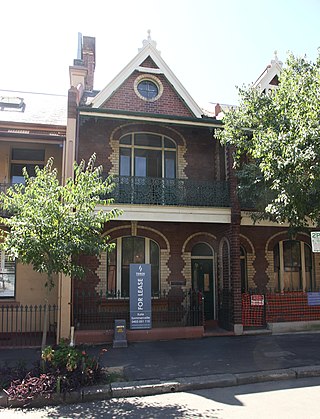
Vermont Terrace is a heritage-listed residence at located 63–65 Lower Fort Street, in the inner city Sydney suburb of Millers Point in the City of Sydney local government area of New South Wales, Australia. The property was added to the New South Wales State Heritage Register on 2 April 1999.

6–8 Argyle Place, Millers Point is a heritage-listed residential accommodation and commercial building located at 6–8 Argyle Place, in the inner city Sydney suburb of Millers Point in the City of Sydney local government area of New South Wales, Australia. The property was added to the New South Wales State Heritage Register on 2 April 1999.

10–12a Argyle Place, Millers Point is a heritage-listed commercial building located at 10, 10a, 12, 12a Argyle Place, in the inner city Sydney suburb of Millers Point in the City of Sydney local government area of New South Wales, Australia. The property was added to the New South Wales State Heritage Register on 2 April 1999.
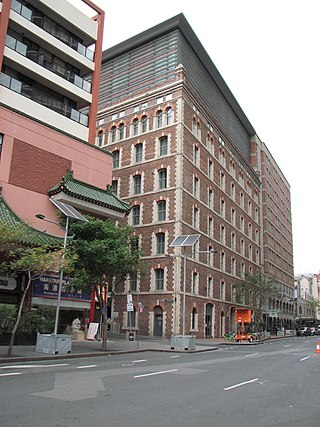
The John Bridge Woolstore is a heritage-listed former warehouse located at 64 Harbour Street, in the Sydney central business district, in the City of Sydney local government area. It was probably designed by either William Pritchard or his son Arthur Pritchard, and was built by Stuart Bros. in 1889. It was added to the New South Wales State Heritage Register on 2 April 1999.

The Corn Exchange is a heritage-listed former market building located at 173–185 Sussex Street, in the Sydney central business district, in the City of Sydney local government area of New South Wales, Australia. It was designed by George McRae and built from 1887. It formerly housed PACT Youth Theatre. It was incorporated into the Nikko Hotel development in the 1980s, but has been commercial office space since the 1990s. It was added to the New South Wales State Heritage Register on 28 June 2002.

Hinchcliff House is a heritage-listed former wool store, hostel for homeless men and university campus at 5–7 Young Street, Sydney, City of Sydney, New South Wales, Australia. The southern section was built c. 1860, while the northern section was built in the 1880s. It is also known as Hinchcliff's Woolstore, Ozanam House and EF House. It was added to the New South Wales State Heritage Register on 2 April 1999.

181–187 Hay Street, also known as the Corporation Building or Municipal Building, is a heritage-listed former council chambers located at 181–187 Hay Street, in the Haymarket district of Sydney, Australia. It was built from 1893. The property is owned by City of Sydney and was added to the New South Wales State Heritage Register on 2 April 1999.

121–127 Sussex Street is a heritage-listed former warehouse and now commercial office building located at 121–127 Sussex Street, in the Sydney central business district, in the City of Sydney local government area of New South Wales, Australia. It was built during 1850. The property is owned by Property NSW, an agency of the Government of New South Wales. It was added to the New South Wales State Heritage Register on 2 April 1999.























